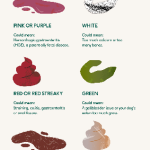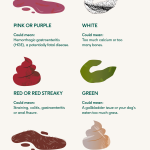As pet owners, we’re always on the lookout for any unusual behavior or symptoms that might indicate our furry friends are not feeling their best. But when it comes to a dog’s stool, there’s one particular anomaly that can leave even the most seasoned pet parents stumped: bloody mucus stools. A seemingly innocuous and easily overlooked issue, bloody mucus stools in dogs can be a sign of a unique health concern that requires prompt attention.
A Unique Health Concern
While it’s not uncommon for dogs to experience occasional gastrointestinal upset or changes in their stool quality, bloody mucus stools are a distinct and potentially serious issue that warrants investigation. So, what is this mysterious phenomenon, and why should you care?
The Anatomy of Bloody Mucus Stools
Bloody mucus stools are characterized by the presence of blood and a thick, slimy substance in your dog’s stool. This unusual combination can be caused by a range of factors, from inflammatory bowel disease to gastrointestinal foreign bodies, or even certain types of cancer. The key takeaway is that bloody mucus stools are not just an annoyance – they’re a sign of underlying inflammation or irritation within the digestive tract.
In this blog post, we’ll delve deeper into the world of bloody mucus stools, exploring the possible causes and potential consequences if left untreated. Whether you’re a seasoned pet owner or a newcomer to the world of canine care, understanding what might be behind your dog’s unusual stool quality is crucial for providing the best possible care.
In our previous discussion, we touched on the topic of bloody mucus stools in dogs – a unique health concern that can leave even the most experienced pet owners scratching their heads. Today, we’ll be diving deeper into the world of gastrointestinal issues and exploring some of the potential causes behind this phenomenon.
The Role of Inflammation
In many cases, bloody mucus stools are a sign of inflammation within the digestive tract. This can be caused by a range of factors, including food sensitivities, allergies, or even infections. When the lining of the intestines becomes inflamed, it can lead to changes in stool quality, including the presence of blood and mucus.
For example, inflammatory bowel disease (IBD) is a common condition that affects both dogs and humans alike. IBD causes chronic inflammation in the digestive tract, leading to symptoms like bloody stools, diarrhea, and abdominal pain. In dogs, IBD can be caused by a range of factors, including genetics, environmental triggers, or even dietary imbalances.
Other potential causes of bloody mucus stools include gastrointestinal foreign bodies, such as ingested toys or objects, which can cause irritation and inflammation within the digestive tract. Similarly, certain types of cancer, such as gastrointestinal tumors, can also cause changes in stool quality.
The Importance of Prompt Attention
If left untreated, bloody mucus stools can lead to a range of complications, including dehydration, malnutrition, and even life-threatening conditions like septicemia. As pet owners, it’s crucial that we’re aware of the potential causes behind our dog’s unusual stool quality and take prompt action to address any underlying issues.
So, what can you do if your dog is experiencing bloody mucus stools? The first step is always to consult with a veterinarian, who will perform a physical examination and may conduct diagnostic tests, such as blood work or imaging studies, to determine the underlying cause of the issue. With proper treatment and care, many cases of bloody mucus stools can be successfully managed.
For more information on canine health and wellness, be sure to check out these resources:
- American Society for the Prevention of Cruelty to Animals (ASPCA) Dog Health Tips
- American Kennel Club (AKC) Canine Gastrointestinal Disorders
In our next installment, we’ll be exploring some of the potential treatment options for bloody mucus stools in dogs. Stay tuned!
Consult a Veterinarian
If you’re concerned about your dog’s health, consult with a veterinarian to get expert advice.
Start chatTo recap, we’ve explored the phenomenon of bloody mucus stools in dogs, a unique health concern that requires prompt attention. We’ve delved into the anatomy of this unusual stool quality, discussing how it can be caused by a range of factors, from inflammatory bowel disease to gastrointestinal foreign bodies or even certain types of cancer.
As we wrap up our discussion on bloody mucus stools, it’s essential to emphasize that ignoring these symptoms can have severe consequences for your dog’s overall health. By recognizing the signs and taking prompt action, you can help prevent complications and ensure your furry friend receives the care they need.
A Call to Action
As pet owners, we’re always looking for ways to improve our dogs’ lives and provide them with the best possible care. Bloody mucus stools may seem like a minor issue, but it’s crucial to address any unusual symptoms or changes in your dog’s behavior.
If you’ve noticed bloody mucus stools in your dog’s stool, it’s time to schedule an appointment with your veterinarian. With their expertise and guidance, you can work together to identify the underlying cause and develop a treatment plan that will get your dog back on track.
A Final Word
As we conclude our discussion on bloody mucus stools, remember that every unusual symptom or change in behavior is an opportunity to strengthen the bond between you and your dog. By staying vigilant and addressing any concerns promptly, you’ll be able to provide the best possible care for your furry friend.
Allergy Eye Drops at CVS: Where to Buy and More: Got itchy, red eyes? Find out where to buy allergy eye drops at CVS and learn more about the best products for your symptoms.
Balanitis vs Herpes: A Picture Comparison of Penis Issues: Don’t be embarrassed by penis issues! Learn to identify balanitis and herpes through pictures, and find out how to treat them effectively.



